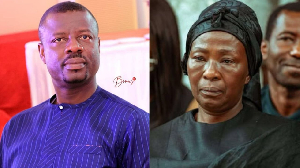(GNA Feature By Hannah Asomaning
Accra August 6, GNA - Driving through the Lobi Community in the Upper West Region of Ghana, one thing that catches the eye are wooden poles along the main streets. They signify the various marriages that have been contracted in the community.
In accordance with custom, marrying someone's wife is a mark of bravery because anyone who is able to marry another man's wife mounts a pole with a red flag on top and every one that marries a young girl also mounts a pole with a white flag on it. Both deeds are acts of victory. Apart from their unique marriage ceremony, Lobi women usually have the lower and upper lips punched to create an opening, which, they say, make them look more attractive to their husbands.
History has it that it is one of the places where slave raiders captured most of their victims during the time of the slave trade. The people were said to have crossed a river that divided the town from Tukpon Island where they sought refuge from slave raiders.
Another interesting thing about the Lobi community is that they still recognise cowries as a legal tender and, therefore, the number of cowries a person possesses is indicative of how rich he or she is.
The people use cowries to pay dowry, funeral contributions, purchase drugs, foodstuffs and any other commodity. Aziz, a 20-year-old first year Junior Secondary School (JSS) student, who talked to the Ghana News Agency, estimates that 10 cowries are equivalent to a thousand cedis.
"It is like we still practise the barter trade system in this community. For example, on market days, someone can come and exchange his yams with your salt or with any other commodity and it is very normal," Aziz said.
GWOLLU
Gwollu, the hometown of Ghana's former and President Dr Hilla Limann is another place where every tourist interested in the activities of the slave raiders must visit. It is a town that has its defence wall still standing. The grave of Dr Limann is located right in the middle of the palace.
The people of Gwollu built this wall, which is bullet proof, to protect themselves from the slave raiders in the 18th century. Gwollu Kuoro (Chief of Gwollu), Kuri-Buktie Limann IV told the Ghana News Agency that the ancestors of the town fought gallantly to protect their people from salve raiders, who usually surrounded the village and set fire to the thatch of their building. The raider would then wait for both men and women to run out, making it easy for them to be captured.
The first wall was built in 1756 but it did not deter the slave raiders from capturing the people because they still had to go out of their homes to fetch water or go to their farms.
It, therefore, became necessary for a second wall to be built to enclose water sources and farmlands to avoid being captured and sold into slavery.
The inhabitants, who still cherish the importance of this wall, have built a fence around it to protect it from totally collapsing. PAGA
The famous Crocodile pond in Paga is well known but there are some citizens in the North, who do not know about the Paga Slave Camp. The people of Paga believe that whenever a Crocodile dies, a royal would also die. In the Paga community, crocodiles are not harmful and one can easily touch a crocodile without being harmed.
The Paga Crocodile Pond has an interesting story surrounding it. Over 600 years ago, a man named Naveh left for a hunting expedition but ended up trapped in a deep dark hole.
Naveh, who was starving, remained in the hole until a crocodile crawled from one of the chambers beside him and led him out through one of the tunnels.
Forever indebted to the crocodile, he left his village and began to search for a new place to settle. In his search, the crocodile followed him until he found a suitable place to settle. He became very rich and attributed his fortune to the crocodile.
He believed that his soul lay within the crocodile and belief is still held by the descendants of Naveh's to this day.
At night in Paga, one sees crocodiles crossing streets and walking through the village looking for food.
Any time a crocodile is about to die, it leaves the pond and comes to town to die. The people in Paga would then organise a funeral for the dead crocodile, with many sympathisers crying and mourning it as if it were a human being.
The Paga Slave Camp is such a beautiful sight but the story surrounding it will easily send an African American into tears. It is an interesting place that every Ghanaian should visit. This slave camp has relics that really tell the story of the slave trade. One can find, for example, slave drums, wells, eating bowls, and the punishment rock, which was used to punish erring slaves.
Professor James Small, Leader of African-Americans living in the USA, told the GNA that the place should be used as a place where they would always come as pilgrims to worship God for Emancipating the African.
SALAGA
Salaga is believed to be the biggest slave market in the country. It was the place where people from all over the country went to buy slaves.Salaga is, therefore, dotted with a lot of slave wells. In fact, one can still find in Salaga the descendants of the some slaves in the community.
Other interesting relics are over 100 slave baths dug by the slaves where they washed down before being sent to the slave market for sale. There is also the Slave Cemetery where dead slaves were thrown away for vultures to feast on. Up till now, children from Salaga refuse to play around the place, where a giant Baobab tree stands.
The warehouse where slaves were kept before they were finally transported to the coast for shipment to their destination still stands. Part of the building is being preserved near the Slave Market.
SAAKPULI
Saakpuli can be called a true hinterland because there is no access road to it and visitors have to walk for eight-and-a-half kilometres to be able to get there.One thing that quickly catches one's attention is the presence of slave wells scattered throughout the town.
The people in Saakpuli are light skinned people, who look exactly like the Fulanis. It was one of the slave markets.
TUMU
The Tumu chief sits on a lion's skin. He told the GNA that as the leader of his people, he adjudicates and sanctions the people at his court.The Chief has shackles that are used to lock villages that misbehave towards him. Any woman visitor, who mistakenly sits on the Chief's lion skin, will automatically become his wife.
When pouring libation, all the elders shout together like the way the Pentecostals pray. They have a song, which they sing as a form of praise to God. The songs move the citizenry so much that some of them scream to express their feelings.
The Northern Region of Ghana has other salve sites, which the writer could not explore.
Africans in the Diaspora are urging that children be taught the true history of the slave trade and the true history of Africa. The slave trade was a very sad event and should never be allowed to happen again.
These relics also stand to promote tourism, which is the third foreign exchange earner in the country.
In spite of the bitterness engendered by the history of the slave trade, it still serves as a very useful lesson to humanity. It allows people to see and treat one another as equals and work to avoid its recurrence in any other form.
Ghana, once a major exit for slaves, now offers itself as the major receptacle or homeland for Africans in the Diaspora.
The people of the Northern Region still have a unique and interesting culture, the most characteristic being their dance; way of greeting and even the kind of food they eat.
Ghana started marking Emancipation Day in 1998 and continues to celebrate it each year as a grim reminder of one of the darkest periods in the history humankind too dreadful to recount and that should never be allowed to recur.














